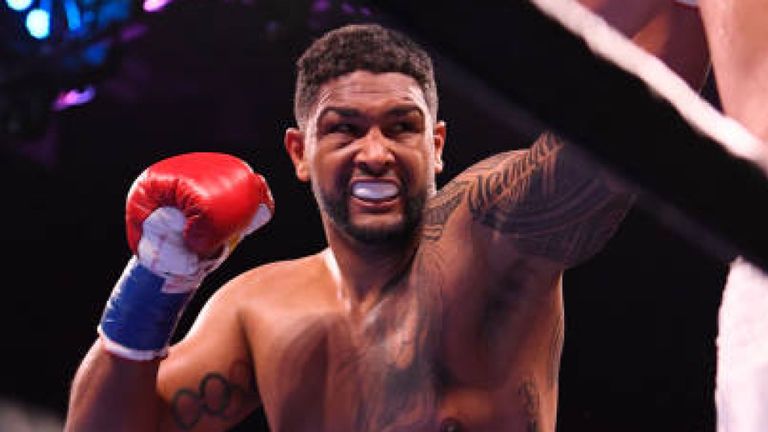Featured Articles
Dominic Breazeale is Easy to Root For

Barclays Center is becoming known for the aroma of weed that wafts through the arena on fight night. But there was a breath of fresh air on Saturday, December 22. His name was Dominic Breazeale.
Breazeale, age 33, comes across as one of the nicest people in boxing. He’s outgoing, friendly, thoughtful, and articulate; has been married for eleven years (“happy wife, happy life,” he says); and is the doting father of three sons.
“I’m a happy person,” Dominic proclaims. “In a gloomy day, I’ll find the sun.”
At 6-feet-7-inches tall and fighting in the neighborhood of 255 pounds, Breazeale is a formidable physical presence. He played quarterback in college at the University of Northern Colorado and took up boxing at age 23.
“Boxing is a hundred times harder than football,” he notes. “If you have a bad day in football, there’s someone else to lean on.”
Breazeale represented the United States in the super-heavyweight division at the 2012 Olympics but lost in an early round to Magomed Omarov of Russia. He turned pro later that year and arrived at Barclays Center sporting a 19-1 (17 KOs) ring record. He most notable fistic outing came on June 25, 2016, when he challenged newly crowned Anthony Joshua for the IBF heavyweight title. Dominic put up a courageous fight but wasn’t skilled enough to prevail. The bout was stopped in the seventh round. He fought twice the following year, stopping Izuagbe Ugonoh and Eric Molina. Breazeale vs. Carlos Negron at Barclays was his first fight in almost fourteen months.
Negron, age thirty, brought a 20-1 (16 KOs) record into the bout. At 6’6″, 226 pounds, he matched up in size against Breazeale. But Carlos, who represented Puerto Rico at 178 pounds in the 2008 Olympics, had been knocked out as a pro by a shopworn Epifiano Mendoza (although that loss came in 2011). Like Breazeale, Negron had been inactive as of late, last fighting eighteen months ago.
All of Breazeale’s strengths and weaknesses were on display against Negron. Words like ponderous, wooden, and slow come to mind when describing his ring style. But he moves inexorably forward and wears lesser opponents down. Negron landed more than he should have, but his punches lacked power. Midway through round nine, Dominic landed a big overhand right on the side of Negron’s neck, dropping him to the canvas and ending the fight.
As for the future, Breazeale is the mandatory challenger for Deontay Wilder’s WBC heavyweight title. But the assumption is that his challenge will be put on hold if Wilder can nail down a more lucrative bout against Tyson Fury or Anthony Joshua in 2019. In that event, the WBC would most likely create some sort of interim-escrow-super-duper belt and seek to match Breazeale against Luis Ortiz or another contender.
That would trouble Breazeale. He wants to fight Wilder because of the challenge that Deontay represents, the money that would be involved, and because of an ugly incident that occurred in a hotel lobby in February 2017 when, in Dominic’s words, “Wilder and a mob of about twenty people unprovokedly attacked my team and my family.”
Meanwhile, reflecting on his role as a boxer, Breazeale says, “The best thing about being a fighter is that we’re one-percenters. It’s nice to know that you’re special.”
And what about the cruelty inherent in his trade? What goes through Dominic’s mind when he’s hurting someone; when he has stiffened an opponent with a jab, stunned him with a follow-up right, and then, as per the demands of his profession, is readying to hit him again?
“I’ve never sat back and analyzed punishing another man,” Breazeale answers. “I’m not sure what I’d find if I did. It’s brutal; I know that. We’re modern-day gladiators. It’s what we sign up for. It’s the nature of the beast.”
Thomas Hauser’s new email address is thomashauserwriter@gmail.com. His most recent book – Protect Yourself at All Times – was published by the University of Arkansas Press. In 2004, the Boxing Writers Association of America honored Hauser with the Nat Fleischer Award for career excellence in boxing journalism.
Check out more boxing news on video at The Boxing Channel
To comment on this article in the Fight Forum, CLICK HERE
-

 Featured Articles4 weeks ago
Featured Articles4 weeks agoThe Hauser Report: Zayas-Garcia, Pacquiao, Usyk, and the NYSAC
-

 Featured Articles3 weeks ago
Featured Articles3 weeks agoOscar Duarte and Regis Prograis Prevail on an Action-Packed Fight Card in Chicago
-

 Featured Articles2 weeks ago
Featured Articles2 weeks agoThe Hauser Report: Cinematic and Literary Notes
-

 Book Review2 weeks ago
Book Review2 weeks agoMark Kriegel’s New Book About Mike Tyson is a Must-Read
-

 Featured Articles4 weeks ago
Featured Articles4 weeks agoRemembering Dwight Muhammad Qawi (1953-2025) and his Triumphant Return to Prison
-

 Featured Articles7 days ago
Featured Articles7 days agoMoses Itauma Continues his Rapid Rise; Steamrolls Dillian Whyte in Riyadh
-

 Featured Articles3 weeks ago
Featured Articles3 weeks agoRahaman Ali (1943-2025)
-

 Featured Articles3 weeks ago
Featured Articles3 weeks agoTop Rank Boxing is in Limbo, but that Hasn’t Benched Robert Garcia’s Up-and-Comers


















